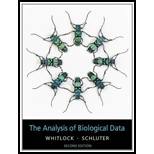
a)
To create: A
a)
Answer to Problem 1PP
It is impossible to comment on the association between the variables using the constructed contingency table
Explanation of Solution
Given information:
Number of men that do not drink coffee = 7890
Number of men who drink coffee more than 6 cups a day = 2492
Number of men who developed cancer in no coffee drinking group = 122
Number of men who developed cancer in high drinking coffee group = 19
Calculation:
Consider, the explanatory variable is Coffee Intake which is shown in the columns and the response variable is the cancer that is shown on the row.
So, the contingency table is constructed as:
| Variables | Coffee Intake | No Coffee Intake | Total |
| Cancer | 19 | 122 | 141 |
| No Cancer | 2473 | 7768 | 10237 |
| Total | 2492 | 7890 | 10382 |
Interpretation:
On the basis of above constructed contingency table, it is impossible to comment on the association between two variables.
b)
To find: The probability of advanced prostate cancer for the high-coffee group.
b)
Answer to Problem 1PP
The probability is 0.00762.
Explanation of Solution
Calculation:
The probability is calculated as:
The required probability is 0.00762.
c)
To find: The probability of advanced prostate cancer for the no-coffee group.
c)
Answer to Problem 1PP
The probability is 0.01546.
Explanation of Solution
Calculation:
The probability is calculated as:
The required probability is 0.01546.
d)
To find: The relative risk of advanced prostate cancer, comparing the treatment and control groups
d)
Answer to Problem 1PP
The probability is 0.01546.
Explanation of Solution
Calculation:
Consider the following table to calculate the relative Risk:
| Coffee | No Coffee | |
| Cancer | 19 (a) | 122 (b) |
| No Cancer | 2473 (c) | 7768 (d) |
The relative risk is computed as:
Hence, the required relative risk is 0.50.
e)
To find: The odds of advanced prostate cancer for high-coffee group.
e)
Answer to Problem 1PP
The odds are 0.0077.
Explanation of Solution
Calculation:
The odds could be calculated as:
The required odds are 0.0077.
f)
To find: The odds of advanced prostate cancer for non-coffee group.
f)
Answer to Problem 1PP
The odds are 0.0157.
Explanation of Solution
Calculation:
The odds could be calculated as:
The required odds are 0.0157.
g)
To compare: The odds ratio of advanced prostate cancer comparing two groups.
g)
Explanation of Solution
Calculation:
The odds ratio is cancer is defined as ratio of the odds of cancer in the coffee- drinking group and the odds of cancer in the non-coffee drinking group.
The odds ratio of cancer for comparing both the groups is:
The required odds ratio is 0.4889.
h)
To find: The log odds ratio comparing these two groups.
h)
Answer to Problem 1PP
The log odds ratio is -0.7156.
Explanation of Solution
Calculation:
The log-odds ratio of cancer for comparing both the groups is:
The required log odds ratio is -0.7156.
i)
To find: The standard error of log odds ratio in the provided case.
i)
Answer to Problem 1PP
The standard error is 0.2477.
Explanation of Solution
Calculation:
Standard Error of the log-odds ratio is
The required standard error is 0.2477.
j)
To find: The 95% confidence interval for the log odds ratio.
j)
Answer to Problem 1PP
The confidence interval is (-1.2011, -0.2301)
Explanation of Solution
Calculation:
The critical value for 95% confidence level is 1.96.
The confidence interval for the log odds ratio is calculated as:
The required confidence interval is (-1.2011, -0.2301)
k)
To find: The 95% confidence interval for the odds ratio.
k)
Answer to Problem 1PP
The confidence interval is (0.3,0.79)
Explanation of Solution
Calculation:
The confidence interval for odds ratio is exponential of confidence interval of log-odds ratio.
The confidence interval is calculated as:
The required confidence interval is (0.3,0.79).
l)
To interpret: The computed confidence interval for the odd ratio. Check if it is consistent with the case that coffee drinking and developing cancer are independent. Also, check if coffee consumption is related to the increased or decreased probability of advanced prostate cancer.
l)
Explanation of Solution
Calculation:
The estimated odds ratio lies in the
The probability of cancer in coffee drinking group is
The probability of not developing cancer in coffee drinking group is:
From above calculation, it is clear that there is significant decrease in developing cancer in coffee drinking group.
Conclusion:
Yes, the coffee consumption is related to the increased or decreased probability of advanced prostate cancer.
Want to see more full solutions like this?
Chapter 9 Solutions
The Analysis of Biological Data
 Glencoe Algebra 1, Student Edition, 9780079039897...AlgebraISBN:9780079039897Author:CarterPublisher:McGraw Hill
Glencoe Algebra 1, Student Edition, 9780079039897...AlgebraISBN:9780079039897Author:CarterPublisher:McGraw Hill Holt Mcdougal Larson Pre-algebra: Student Edition...AlgebraISBN:9780547587776Author:HOLT MCDOUGALPublisher:HOLT MCDOUGAL
Holt Mcdougal Larson Pre-algebra: Student Edition...AlgebraISBN:9780547587776Author:HOLT MCDOUGALPublisher:HOLT MCDOUGAL


